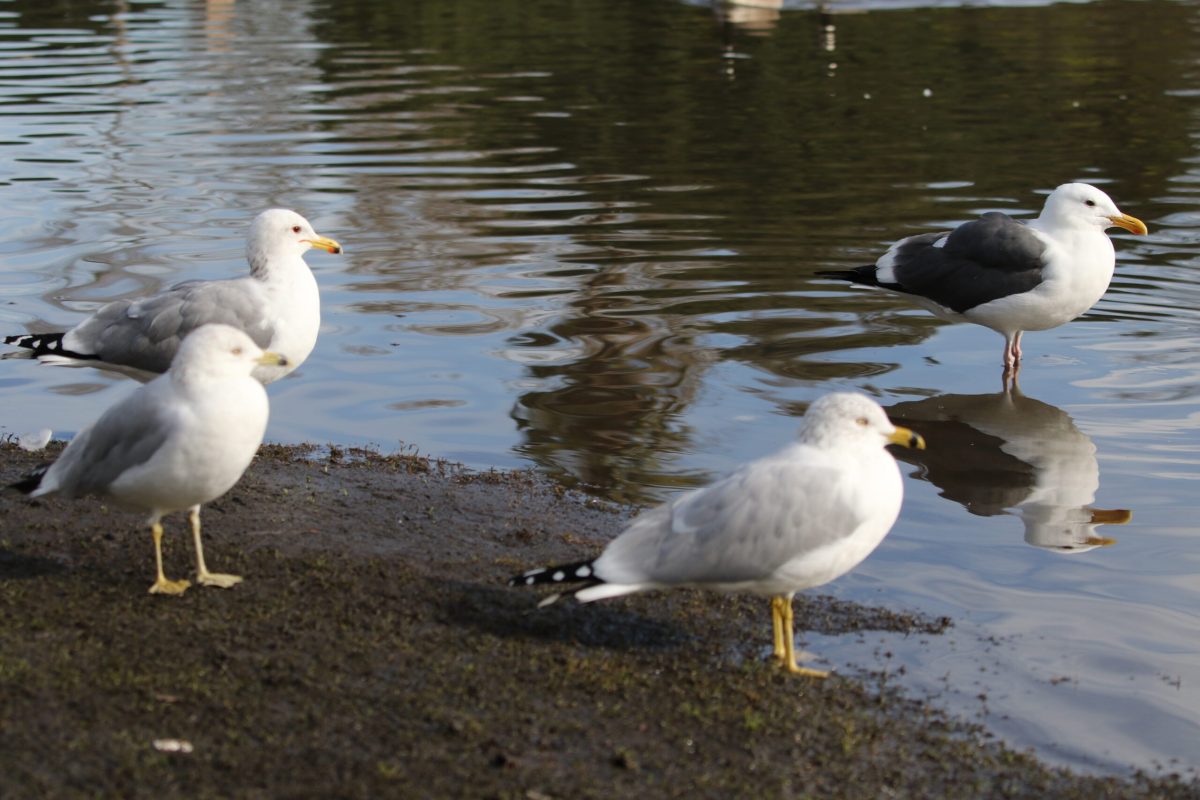by Bob Shanman
Last month, I introduced you to one of my favorite birds, the Heermann’s Gull. They are white-headed like most gulls. But with their slate-gray bodies, red bill and black feet, they are easily sorted out from the rest of the gulls. They have now left for their breeding colonies in Mexico, leaving behind their more difficult-to-identify cousins.
Gulls are always a challenge to sort out (I find it fun to pick through a gull flock for the odd bird). But with a little effort, you can become the local expert, and wow your friends with all you know about (sea)gulls.
Gulls are sometimes referred to as the garbage folks of the bird world, given their penchant for finding food at garbage dumps, trash cans and your lunch bags at the beach. They are quite clever at figuring out how to open packages. They will use rock jetties or concrete surfaces to drop shellfish on to break them open. They even chase other birds (especially terns), forcing them to give up food they have caught.
Of the 20 or so gull species that have been seen in Los Angeles County, the three species described below are the most abundant on our beaches. They are all similar in appearance. But look closely, and you will quickly see differences. Start with size, then the beaks and feet. Among the adult birds, one has a heavy yellow beak with a red spot where it thickens near the tip. The second has a thinner beak, also yellow, but with a red and black spot near the tip. The third gull has a short yellow beak with a black ring near the tip.
When we look at the legs of these three gulls, we see that the first has pink legs (in all plumages), the second has dull grayish green legs in winter (turning more yellow in late spring), and the third has yellow legs, becoming almost lemon yellow in breeding plumage. The wingtips extend past the snow-white tail of these birds.
The first, and largest of the three, is the Western Gull. The second is the California Gull. The third, and smallest, is the Ring-billed Gull. All are considered to be “medium-sized” gulls, but there is a significant difference in size (my thanks to the birds for posing as a group at Polliwog Park). Males are larger than the females in each species; otherwise, males and females look the same. All three species breed away from the South Bay, leaving only juvenile and subadult birds here in the summer. If you want a challenge, try sorting out the young birds from each other, and guess their ages by their plumage during those lazy days on the beach in July and August.
The Western Gull is strictly a west-coast bird, found between Baja California and Vancouver, British Columbia. It breeds primarily on rocky, offshore islands, with thirty percent of the total population breeding on the Farallon Islands. Its appearance overall is bulky. The birds are 23 to 26 inches long (tip of bill to tip of tail), and have a wingspan of four to five feet. When perched, the wings and back are dark gray, the underside is white. In flight, the upper wing appears black, emphasizing the wide, bright white trailing edge of the underwing. The white “windows” on the wing of the perched bird are the white wingtips seen in flight.
Western Gulls begin breeding at age four or five and mate for life. Eggs hatch at about four to five weeks, and the young fledge about seven weeks later. They may stay with, and be fed by, the parents for up to six months. (They do nest locally on occasion — I have seen nests with young in Los Angeles Harbor.) Western gulls can live into their twenties. The oldest known bird was 33 years and 11 months. This is from a band observed on a flying bird! (More info on bird longevity can be found at the Bird Banding Laboratory website pwrc.usgs.gov/BBL/Bander_Portal/login/Longevity_main.php.)
The California Gull, while still “bulky” is slenderer than the Western Gull. The range of the California Gull is more extensive, extending north into the southern portion of the Northwest Territories in Canada and as far east as western Manitoba. California Gulls breed in a wide range of inland lakeshore habitats and manage to survive even where food may be sparse. Colonies range in size from several hundred to about 43,000 birds (at Great Salt Lake). Colony sizes at Mono Lake have ranged from about 2,000 to 40,000 birds.
California Gulls breed in their fourth year, but there are records documenting breeding as early as the second year. The typical clutch size is two to three eggs, which hatch in 25 to 26 days. It takes another six weeks for the young birds to fledge. So, the largest colonies could approach 100,000 birds, which is just hard to imagine. Once the young have fledged, they are on their own. California gulls regularly live into their twenties, with the oldest documented age being 28 years and 3 months in 2013. The bird was alive but injured when the band was read and reported.
A typical California Gull is about 22 inches long with a wingspan of 48 inches to 54 inches. When standing, they have a medium gray back and wings. The paler (compared to the Western Gull) upper wing results in less emphasis on the white trailing edge of the underwing. The white windows in the folded wing are not visible in flight except for the very tip of the wing, giving the wingtips an overall black appearance from below. This is another way to sort out the California Gull from the Western Gull in flight.
The total population for the California Gull is estimated at between 500,000 and one million birds. It is the state bird of Utah, having arrived in time to wipe out the great locust invasion of 1848, saving the crops of the Mormon settlers. It winters exclusively along the west coast and is common along South Bay beaches.
The last of the three birds is the Ring-billed Gull, named for the black band that rings the tip of the bill. It is the smallest of the three species and is readily identifiable as an adult by the black ring, its bright yellow eyes, and yellow legs. Ring-billed Gulls are found across the United States and Canada, and range as far south as the northern Pacific and Caribbean coasts of South America. There is even one record (1983) from the Galapagos Islands.
Ring-billed gulls are 16 to 20 long, with a wingspan up to about 48 inches. Their wings and back are medium to light gray. The light gray upper wing results in the trailing edge not being distinct from the rest of the underwing. The white windows in the wingtips show in flight.
The breeding range of the Ring-billed Gull is a wide swath, stretching from northeastern California north to the southern Northwest Territories, and east to the Maritime Provinces. Locally, wintering birds are present along the west coast, and inland to Imperial County and along the Colorado River. Adults begin to arrive in late summer and begin their spring migration in March. Most breeding birds are gone by mid-May. Birds begin breeding at three to four years. Mated pairs will have one to three eggs that hatch at about 30 days. It takes about 45 days for the young to fledge. Both parents feed the young, but the family group breaks up within days of fledging, so the young are on their own very quickly. Experiments on young birds have shown that within days of hatching they begin to orient themselves in the direction of their fall migration. Population estimates for this gull range as high as ten million individuals (2009).
So, there you have it. More than you ever wanted to know about (sea) gulls. You can now walk along The Esplanade and wow your friends with all you know about (sea) gulls.
Have a bird you see on the coast that you would like to learn more about? Let the folks know at the Easy Reader. Next month, a little cutie and a flashy dude and duchess.
Good birding and stay safe along the coast.











